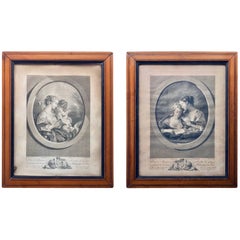François Boucher for sale on 1stDibs
The extraordinary career of Francois Boucher was unmatched by his contemporaries in versatility, consistency and output. For many, particularly the writers and collectors who led the revival of interest in the French rococo during the last century, his sensuous beauties and plump cupids represent the French eighteenth century at its most typical. His facility with the brush, even when betraying the occasional superficiality of his art, enabled him to master every aspect of painting – history and mythology, portraiture, landscape, ordinary life and, as part of larger compositions, even still life. He had been trained as an engraver, and the skills of a draftsman, which he imbued in the studio of Jean-Francois Cars (1661 – 1738), stood him in good stead throughout his career; his delightful drawings are one of the most sought-after aspects of his oeuvre. As a student of Francois Lemoyne (1688 - 1737), he mastered the art of composition. The four years he spent in Italy, from 1727-1731, educated him in the works of the masters, classics and history, that his modest upbringing had denied him. On his return to Paris in 1734, he gained full membership of the Royal Academy of Painting and Sculpture with his splendid Rinaldo and Armida (Paris, Musée du Louvre). Although, throughout his career, he occasionally painted subjects taken from the Bible, and would always have considered himself first as a history painter, his own repertoire of heroines, seductresses, flirtatious peasant girls and erotic beauties was better suited to a lighter, more decorative subject matter. His mastery of technique and composition enabled him to move from large scale tapestry cartoons (he worked throughout his career for both the Beauvais and Gobelins tapestry factories, becoming director of the latter in 1755), to intimate masterpieces such as Diana Resting (Paris, Louvre) or Leda and the Swan and the occasional scene from everyday life such as The Luncheon (Paris, Louvre), with its elegantly dressed figures grouped around a well-laid table.
Enormously successful and widely bought, Boucher’s output was prodigious. First patronized by the Crown in the 1730s, and appointed Premier Peintre du Roi in 1765, he executed numerous royal and princely commissions until his death in 1770, working particularly for Louis XV’s mistress, the Marquise de Pompadour in each of her several palaces. Always ready to utilize his talents in other fields, he designed stage sets for theatre and opera and supplied drawings to be used as designs for figures at the Vincennes (later Sèvres) porcelain factory. As a teacher, he was much loved by his many students, who included Fragonard, Le Prince, Deshays, Brenet, Baudouin, Lagrenee, and Madame de Pompadour herself.
In his earliest surviving works with their colourful rococo palette, even David, a distant cousin, was clearly influenced by Boucher. Not since Le Brun had a single French artist held such a monopoly on the imagery of a particular society or left such a mark on the art of his time.
Finding the Right picture-frames for You
Picture frames have the distinct role of presenting artwork in your home. A good frame can elevate the appearance of a fine oil painting or provocative fine-art photograph. From ornate handcrafted designs to streamlined wooden styles, some antique, new and vintage picture frames have become stand-alone pieces of art on their own.
Frames were originally a part of paintings themselves before they were separate structures carved from walnut and other woods for use with items like portrait paintings and mirrors. The design of frames evolved in Renaissance-era Italy, where an artist might create his own gilded or painted frame. Today, there are all kinds of picture frames made from a variety of materials, including silver, bronze and acrylic.
Displaying art in the home is an art in and of itself, and trends and new art movements have dictated how picture frames have been integrated into home interiors over the years. When Abstract Expressionist art emerged during the 1930s, for example, collectors utilized minimalist frames to hang abstract works or dispensed with frames entirely. Today, mixing mediums and frame designs make for endless combinations, but knowing how to arrange wall art can help even if you’re feeling adventurous.
Whether it’s a dark wood frame for your landscape paintings, a sleek chrome mid-century modern frame to show off your black-and-white photography or a bold Art Deco frame that might completely outshine its subject, find an extensive collection of antique, new and vintage picture frames on 1stDibs.
